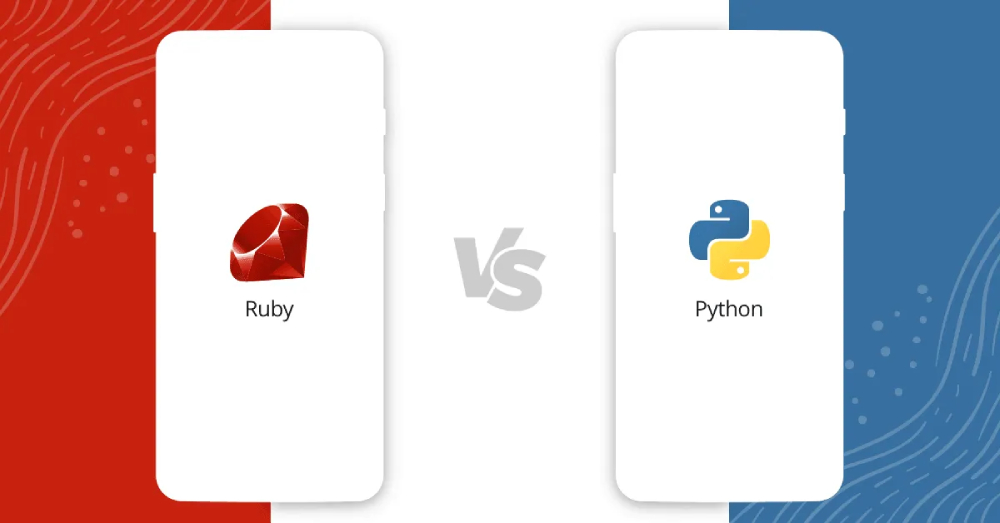
Ruby vs Python for web development: A 6-criterion comprehensive comparison
Selecting the right programming language is a crucial decision for any web development project. The enduring debate between Ruby and Python for web development often takes center stage, as both are powerful, high-level, interpreted, and object-oriented languages popular for building robust web applications. This article aims to provide an in-depth comparison of Ruby and Python, helping developers, project managers, technical leads, and aspiring web developers make informed decisions.
| Criterion | Ruby | Python |
| Core philosophies | “Programmer happiness,” elegance, flexibility, Principle of Least Astonishment (POLA). | Clarity, simplicity, “one obvious way,” “batteries included,” Zen of Python. |
| Syntax & readability | Expressive, “human-like” syntax, multiple ways to achieve tasks. | Clear, concise, explicit syntax, enforced indentation. |
| Web frameworks | Ruby on Rails (convention over configuration, rapid development, MVC), Sinatra (lightweight). | Django (DRY, comprehensive, “batteries-included”), Flask (micro-framework, customizable). |
| Performance & scalability | Interpreted, Global Virtual Machine Lock (GVL), solutions like Puma. Actual performance depends on implementation. | Interpreted, Global Interpreter Lock (GIL), solutions like Gunicorn. Actual performance depends on implementation. |
| Libraries & ecosystems | RubyGems (extensive for web development, but less overall diversity). | PyPI (massive, diverse, strong in web, data science, ML, AI, scientific computing). |
| Community & support | Dedicated, passionate community, historically strong in web development. | Significantly larger, more diverse, rapidly growing, spanning various domains. |
| Learning curve & productivity | Initially easy, but metaprogramming can add complexity. High productivity with Rails. | Easier for beginners due to clear syntax. Good productivity across many tasks. |
| Job market & future trends | Demand varies by region/industry. Strong industry adoption. | Significant growth in AI and data science, influencing long-term adaptability. |
1. Core philosophies
Ruby – The art of programming:
- Championed by Yukihiro “Matz” Matsumoto, Ruby’s philosophy centers on “programmer happiness.”
- Prioritizing elegance, readability, and developer productivity.
- Offering high flexibility and powerful metaprogramming capabilities, adhering to the Principle of Least Astonishment (POLA), meaning things should work as you’d expect.
Python – The zen of simplicity:
- Guided by the “Zen of Python” (Tim Peters), Python emphasizes clarity, simplicity, and often a single, obvious way to do things.
- Its readability is enforced through significant whitespace.
- Following a “batteries included” philosophy, offering an extensive standard library.
2. Syntax and readability
Ruby: Boasts an expressive, “human-like” syntax that allows for multiple ways to achieve tasks. This can lead to highly concise and elegant code.
Python: Features a clear, concise, and explicit syntax, with enforced indentation defining code blocks. This often results in more uniform and easily understandable code across different projects and developers.
3. Web frameworks
Ruby:
- Ruby on Rails (RoR): Famous for “convention over configuration,” enabling rapid development through features like scaffolding and ActiveRecord. It’s exceptionally well-suited for Model-View-Controller (MVC) architecture.
- Sinatra: A lightweight, minimalist framework ideal for smaller APIs or web applications where less overhead and more control are desired.
Python:
- Django: Adheres to the “Don’t Repeat Yourself (DRY)” principle. It’s a comprehensive, “batteries-included” framework with an ORM and admin panel, making it suitable for large-scale applications requiring a full-stack solution.
- Flask: A micro-framework that is highly customizable, perfect for smaller projects and APIs, allowing developers to choose their components. Other notable frameworks include Pyramid and FastAPI.
4. Performance & scalability
Both Ruby and Python are interpreted languages. While general benchmarks exist, actual runtime performance often depends more on specific project implementation, efficient algorithm design, and database optimization rather than the language itself.
Concurrency and Parallelism:
- Python: Has the Global Interpreter Lock (GIL), which limits true parallel execution of threads in a single process. Solutions like Gunicorn help manage this by running multiple processes.
- Ruby: Has the Global Virtual Machine Lock (GVL), similar in concept to Python’s GIL. Solutions like Puma (for Ruby) facilitate concurrency by handling requests across multiple threads and processes.
The community’s focus on performance and available scaling solutions also varies, with both languages having mature deployment strategies.
5. Libraries & ecosystems
RubyGems (Ruby):
- Provides an extensive collection of libraries (gems) specifically for web development, covering a wide range of functionalities from authentication to payment processing.
- While robust for web, its overall diversity might be less compared to Python in other domains.
PyPI (Python Package Index):
- A massive and incredibly diverse ecosystem, strong not only in web development but also in data science, machine learning, artificial intelligence, and scientific computing.
- This breadth significantly impacts project scope and integration with other domains, offering unparalleled access to specialized tools.
6. Learning curve & productivity
Ruby:
- Often seen as initially easy to learn due to its expressive syntax and focus on developer happiness.
- However, its metaprogramming capabilities and multiple ways to achieve tasks can add complexity at advanced levels. Ruby on Rails offers very high developer productivity due to its “convention over configuration” approach.
Python:
- Frequently cited as easier for beginners due to its clear syntax and explicit nature, making it a popular choice for introductory programming courses.
- Offers good productivity across many tasks, aided by its extensive standard library and diverse third-party packages.

Source: techaheadcorp.com
Conclusion: When to use Ruby? When to use Python?
Both Ruby and Python are powerful, viable choices for web development. The “best” option isn’t universal; it truly depends on your specific project context, team capabilities, and long-term vision.
When to choose Ruby (and Rails)?
- Rapid prototyping and MVP development: Especially popular with startups looking to quickly bring ideas to market.
- Projects prioritizing high developer productivity and the convention-over-configuration paradigm: When speed of development is paramount.
- E-commerce platforms: Shopify, a leading e-commerce platform, is famously built on Rails.
- Content Management Systems: Where structured data and administrative interfaces are key.
- Applications where elegant code and a superior developer experience are paramount: For teams that value a highly expressive language.
Famous websites using Ruby (and Ruby on Rails):
- Shopify: This e-commerce giant leverages Rails to create a stable and scalable system, enabling millions of online stores to operate efficiently.
- GitHub: Built on Rails, GitHub provides a seamless environment for collaboration and source code management, serving millions of developers worldwide.
- Airbnb: The pioneering online booking platform harnesses Rails for rapid development and scaling, easily connecting millions of travelers with hosts.
- Basecamp: As the project management tool that famously gave birth to the Rails framework itself, Basecamp exemplifies its effectiveness in building highly productive and collaborative web applications.
- Hulu: This popular streaming service uses Rails to manage its extensive content library and deliver a smooth viewing experience to its users.

Shopify is one of the famous platforms built on Ruby on Rails – Source: fptshop.com.vn
When to choose Python (and Django/Flask)?
- Data-intensive applications requiring AI/ML integration: Python’s unparalleled ecosystem for data science makes it the go-to choice.
- Large-scale, complex web applications need robust, batteries-included frameworks: Django offers comprehensive features out of the box.
- Backend APIs for mobile or single-page applications: Both Django and Flask are excellent for building powerful APIs.
- Projects with diverse needs beyond just web: Such as data analysis, scientific computing, automation, and system administration.
- Startups and enterprises that prioritize broad versatility and access to a large talent pool: Python’s widespread adoption means a larger pool of developers.
Famous websites using Python:
- Instagram: This social media giant uses Django (a Python web framework) to handle its massive scale, allowing for rapid growth and seamless photo/video sharing.
- Spotify: Python powers Spotify’s backend, especially for data analysis and personalized recommendations (like “Discover Weekly”), ensuring users discover more of what they love.
- Netflix: Python is crucial for Netflix’s recommendation engines, data analytics, and content delivery, enabling the platform to offer a highly tailored and smooth streaming experience.
- Dropbox: Utilized on both server and client sides, Python’s cross-platform capabilities and readability were key to building this reliable and widely accessible cloud storage service.
- Reddit: Python’s extensive libraries and ease of development allowed Reddit to scale efficiently with its massive user base and diverse content, making it a robust community hub.
>>> At PowerGate Software, we’ve extensively worked with both Ruby and Python in various web development projects, observing how each language’s unique characteristics impact development workflows, team dynamics, and project outcomes. You can refer to our services via:

PowerGate Software has extensively worked with both Ruby and Python in various web development projects
In summary, at PowerGate Software, we believe that understanding the nuances of each language is crucial for making an informed decision when it comes to choosing between Ruby and Python for web development. Both Ruby and Python can power successful web applications. The decision between Ruby and Python should reflect your team’s strengths, project requirements, and long-term objectives. Both languages offer mature, well-supported ecosystems backed by vibrant communities and extensive resources for learning and problem-solving.

